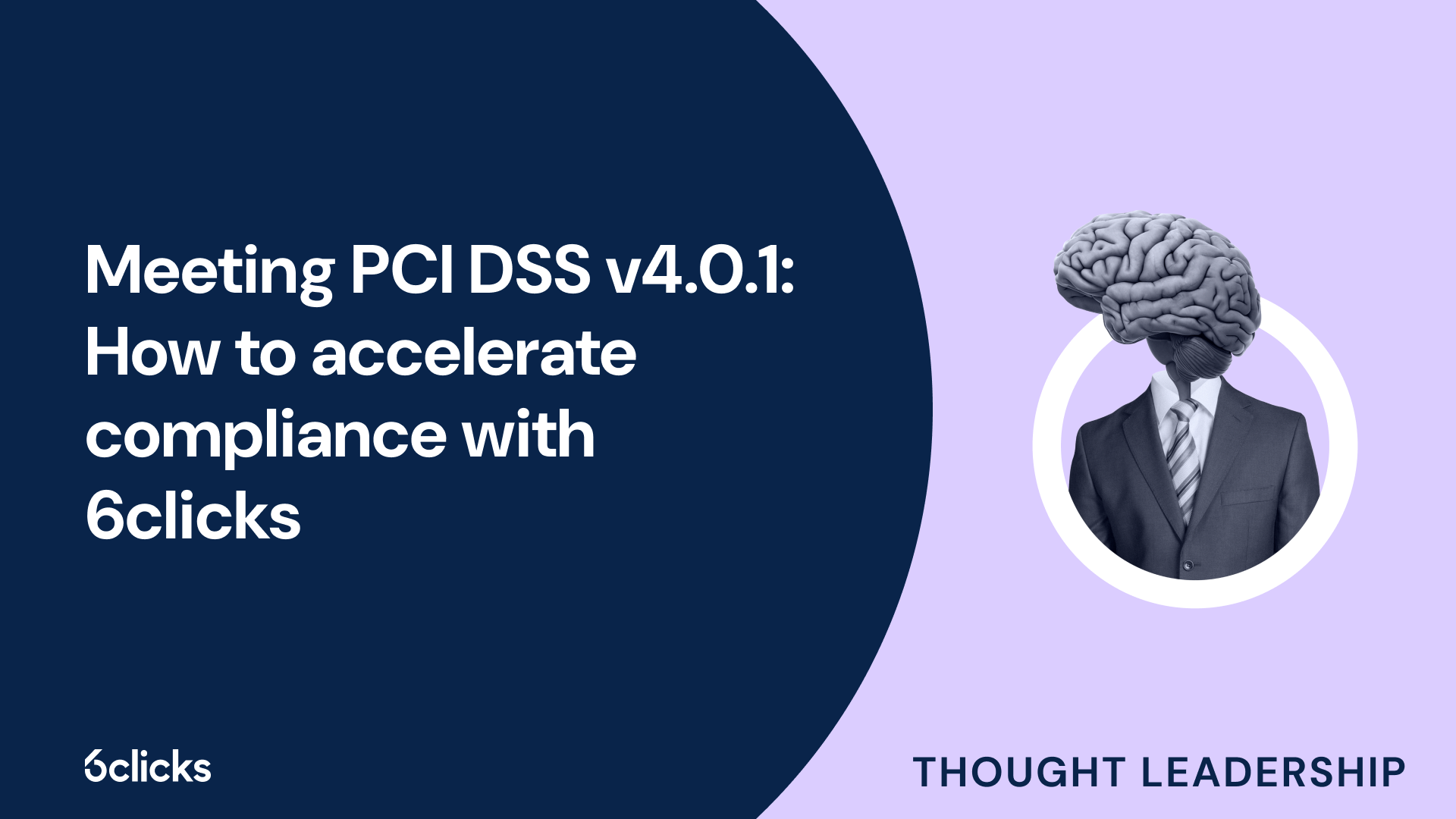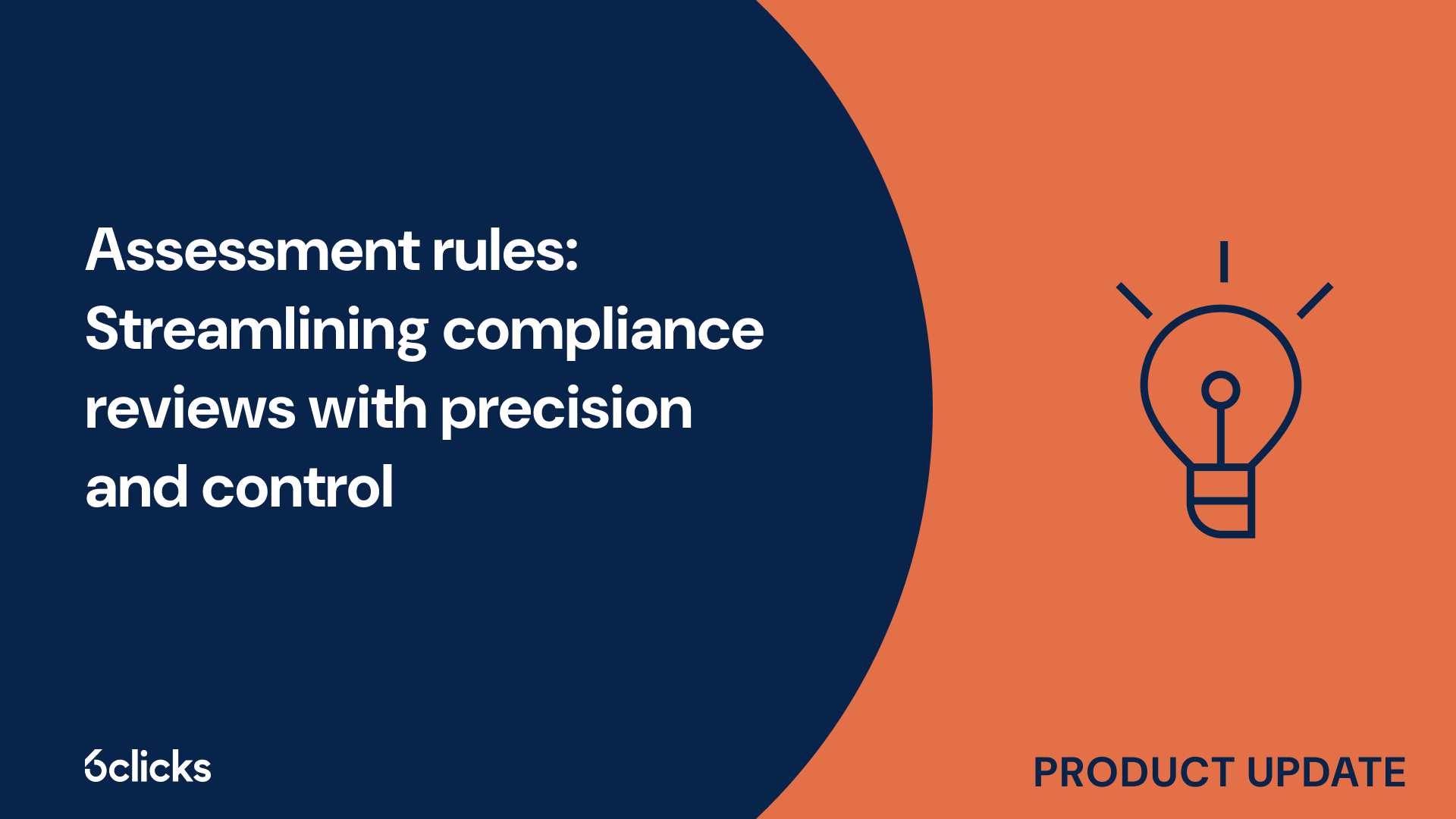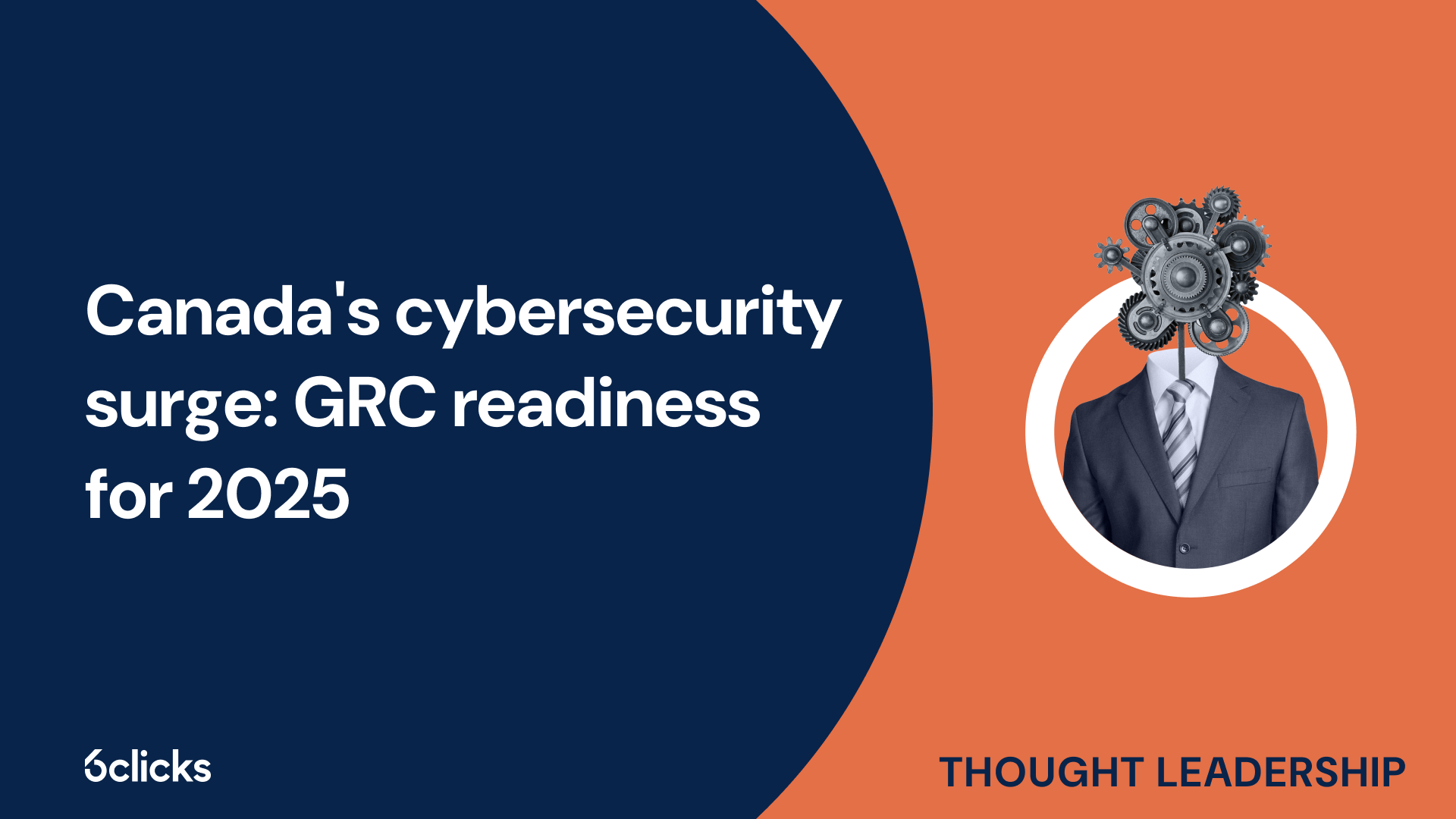Cyber resilience in 2025: Your smart guide to NIST CSF
Boost your organization's cyber resilience with this expert guide to the NIST Cybersecurity Framework. Learn to assess risk, improve security posture, and automate compliance with AI-powered tools.
-1.png?width=200&height=249&name=Group%20193%20(1)-1.png)
Cyber resilience in 2025: Your smart guide to NIST CSF
What is the NIST cybersecurity framework (CSF)?
The NIST Cybersecurity Framework (CSF) is a set of guidelines, standards, and best practices developed by the National Institute of Standards and Technology (NIST) to help organizations manage and mitigate cybersecurity risks. It provides a flexible framework that can be adapted to different industries and organizations of all sizes. The framework consists of three main elements: the Core, the Implementation Tiers, and the Framework Profile. These elements work together to provide organizations with a common language and a structured approach to managing and improving their cybersecurity posture. By using the NIST CSF, organizations can assess their current cybersecurity practices, identify gaps and areas for improvement, and develop and implement a comprehensive cybersecurity program that aligns with their business goals and risk tolerance.
Overview of the three main elements
Overview of the Three Main Elements of the NIST Cybersecurity Framework (CSF)
The NIST Cybersecurity Framework (CSF) is a widely recognized framework that helps organizations manage and mitigate cybersecurity risks. It provides a common language for organizations to express their cybersecurity risk management objectives and activities.
The framework consists of three main elements: the Core, the Implementation Tiers, and the Framework Profile.
- The Core: The Core is the heart of the NIST CSF and is divided into five functions - Identify, Protect, Detect, Respond, and Recover. Each function focuses on a specific aspect of cybersecurity risk management. Under each function, there are categories that further define the desired cybersecurity outcomes. These categories help organizations identify and prioritize their cybersecurity requirements and controls.
- The Implementation Tiers: The Implementation Tiers provide a mechanism to determine and assess an organization's current level of cybersecurity sophistication and maturity. There are four tiers: Partial, Risk-Informed, Repeatable, and Adaptive. These tiers help organizations gauge their progress in implementing cybersecurity activities and choose the level of rigor suitable for their risk strategy and business requirements.
- The Framework Profile: The Framework Profile allows organizations to build a customized view of their current cybersecurity posture. It helps align the organization's cybersecurity activities with its business objectives, risk tolerances, and available resources. The profile serves as a roadmap for organizations to prioritize their cybersecurity investments and establish a target state for their cybersecurity activities.
Element 1: identify
The first element of the NIST Cybersecurity Framework is "Identify," which focuses on helping organizations develop an understanding of their cybersecurity risks and the potential impact they can have on their business operations. This element involves identifying and documenting critical assets, systems, and data that are crucial to the organization's operations. It also requires organizations to establish a comprehensive understanding of the internal and external factors that can affect their cybersecurity posture, such as regulatory requirements, industry standards, and the current threat landscape. By identifying these key aspects, organizations can effectively assess and prioritize their cybersecurity risks and develop a tailored strategy to manage and mitigate them. This element is essential as it lays the foundation for implementing appropriate protective measures and establishing a strong cybersecurity posture. By adopting the "Identify" element of the NIST CSF, organizations can gain a clear understanding of their cybersecurity risks and make informed decisions to safeguard their critical infrastructure and sensitive information.
Risk assessment and management
Risk assessment and management are critical components of the NIST Cybersecurity Framework (CSF), enabling organizations to identify, prioritize, and mitigate cybersecurity risks.
The first step in the process is to identify and understand the potential cybersecurity risks that an organization may face. This involves conducting a comprehensive assessment of the organization's systems, networks, and data to identify vulnerabilities and potential threats. This assessment should also take into consideration the organization's mission objectives, business requirements, and regulatory requirements.
Once the risks are identified, organizations can then prioritize them based on their potential impact on the organization's operations and the likelihood of occurrence. This allows organizations to focus their resources on mitigating the most significant risks first.
Next, organizations develop and implement risk mitigation strategies to reduce the likelihood and impact of a cybersecurity incident. This may involve implementing security controls, protective measures, and cybersecurity policies that are aligned with industry standards and best practices.
It is important to note that risk management is an iterative process. Organizations must continuously monitor and assess their cybersecurity risks, as new threats emerge and the business environment evolves. Ongoing risk management activities include monitoring for breach incidents, evaluating the effectiveness of mitigation strategies, and updating the risk management strategy as needed.
By following the risk assessment and management process outlined in the NIST CSF, organizations can effectively identify, prioritize, and mitigate the cybersecurity risks they face, enhancing their overall cybersecurity posture.
Asset management
Asset management is a crucial element of the NIST Cybersecurity Framework (CSF), as it helps organizations effectively identify, categorize, and protect their assets. By establishing a comprehensive understanding of their assets, organizations can better determine the value and criticality of each asset.
The first step in asset management is to identify and categorize the various types of assets within an organization, such as physical assets, information assets, and personnel. This process allows organizations to gain visibility and control over their assets, ensuring that they are accounted for and properly protected.
Determining the value and criticality of assets is the next step in asset management. This involves assessing the impact that the loss, compromise, or disruption of an asset would have on the organization's operations and goals. By understanding the importance of each asset, organizations can prioritize their protection efforts and allocate resources accordingly.
Once assets are identified and their value is determined, appropriate safeguards can be established. These safeguards may include security controls, policies, and procedures that help protect assets from unauthorized access, use, disclosure, alteration, or destruction. By implementing these safeguards, organizations can minimize their exposure to cybersecurity risks and protect their critical assets.
Furthermore, asset management plays a vital role in supporting risk management processes. By having a clear understanding of their assets, organizations can effectively identify and assess potential risks that may impact these assets. This allows organizations to make informed decisions and implement appropriate risk mitigation strategies.
Awareness and training
Awareness and training are key elements of the NIST Cybersecurity Framework (CSF) that organizations should focus on to strengthen their cybersecurity posture. These elements play a crucial role in educating stakeholders and ensuring they are equipped with the knowledge and skills necessary to protect against cybersecurity risks.
Training stakeholders is an essential aspect of cybersecurity awareness. This involves providing training to employees and other individuals who have access to the organization's systems and data. By educating stakeholders about the potential risks and best practices for mitigating them, organizations can reduce the likelihood of cyber incidents caused by human error or negligence.
Creating effective training materials is another important aspect of awareness and training. These materials should be comprehensive, clear, and tailored to the specific needs of the organization. They should cover topics such as password hygiene, recognizing phishing scams, data protection policies, and incident reporting procedures. By developing engaging and informative training materials, organizations can ensure that their stakeholders have the necessary knowledge to protect against cybersecurity threats.
Disseminating information about consumer protection law and scams is a critical component of cybersecurity awareness. In an increasingly digital world, individuals need to understand their rights and responsibilities related to consumer protection and be able to identify and report scams. By providing training and educational materials on these topics, organizations can empower their stakeholders to be informed and vigilant consumers, thereby reducing the likelihood of falling victim to cybercrime.
Element 2: protect
Protecting an organization's systems and data is crucial in ensuring cybersecurity. This involves implementing controls and measures to prevent or minimize the impact of potential cyber threats. Element 2 of the NIST Cybersecurity Framework (CSF) focuses on protecting the organization from risks and vulnerabilities that could compromise its critical functions and information. This element includes the development and implementation of security controls, policies, and procedures to safeguard the organization's assets. It also emphasizes the need for ongoing monitoring, detection, and response to cybersecurity incidents. By prioritizing the protection of sensitive data, systems, and networks, organizations can strengthen their resilience against cyber threats and reduce the potential impact of security breaches.
Access control and identity verification
Access control and identity verification are essential elements in implementing the NIST Cybersecurity Framework (CSF). These components play a crucial role in protecting critical information and systems from unauthorized access and cyber threats.
Access control ensures that only authorized individuals are granted access to sensitive data and resources, while identity verification ensures that the person requesting access is who they claim to be. These measures are important for maintaining the confidentiality, integrity, and availability of information, as well as preventing unauthorized modification or destruction of data.
NIST provides comprehensive guidance on access control and identity verification through its special publications, specifically NIST 800-53 and NIST 800-171. These publications outline the necessary controls that organizations should design and implement to protect their information systems. They provide a framework for organizations to assess and manage risks, select and implement appropriate controls, and monitor and maintain these controls.
Key components of access control and identity verification that organizations should consider include user roles and permissions, multi-factor authentication, and privileged access management. User roles and permissions ensure that individuals are only granted access to the information and resources necessary for their job roles. Multi-factor authentication adds an extra layer of security by requiring users to provide multiple forms of identification, such as a password and a fingerprint scan. Privileged access management helps control and monitor access to critical systems and data, limiting the number of individuals who have administrative privileges.
Data security and encryption
Data security and encryption play a crucial role in the NIST Cybersecurity Framework (CSF) by providing measures to protect sensitive information from unauthorized access or disclosure. Data security is vital to organizations as it safeguards confidential data, prevents data breaches, and ensures compliance with privacy regulations.
Encryption, a prominent data security measure, involves converting data into an unreadable format that can only be accessed with an encryption key. The NIST CSF recognizes the importance of encryption in safeguarding sensitive information and recommends its implementation as a protective measure.
The framework recommends various encryption methods to ensure the confidentiality and integrity of data. These include symmetric-key encryption, where the same key is used for both encryption and decryption, and asymmetric-key encryption, which utilizes a public and private key pair. Additionally, the framework emphasizes the use of secure algorithms and key management practices to enhance encryption efficacy.
Implementing encryption measures assists organizations in mitigating the risks associated with unauthorized access to sensitive data and safeguarding critical information from potential breaches. By following the guidelines provided by the NIST CSF, organizations can establish robust data security practices that align with industry standards and protect their valuable assets from cyber threats.
Network security
Network security is a crucial aspect of cybersecurity, and it plays a significant role in the NIST Cybersecurity Framework (CSF). The CSF provides a comprehensive guide for organizations to manage and mitigate cybersecurity risks, and it recognizes the importance of network security as a foundational element.
Within the CSF, network security refers to the measures and strategies implemented to protect the integrity, confidentiality, and availability of an organization's network infrastructure. It aims to prevent unauthorized access, data breaches, and other network-related threats that can compromise critical systems and services.
To ensure network security, the CSF emphasizes several key principles and strategies. Firstly, organizations need to have a clear understanding of their network architecture, including the inventory of network assets and the identification of critical network components. This enables them to prioritize security efforts and allocate resources effectively.
Another key principle is the establishment of strong access controls. This involves implementing mechanisms such as firewalls, intrusion detection and prevention systems, and robust authentication mechanisms to restrict unauthorized access to the network.
Regular monitoring and continuous threat detection are also critical in maintaining network security. This includes implementing robust detection processes, conducting regular vulnerability assessments, and monitoring network traffic for suspicious activities.
Lastly, organizations should have proper incident response and recovery plans in place to swiftly identify, contain, and recover from network security incidents. This includes having a well-defined incident response team, conducting regular drills, and establishing communication channels with relevant stakeholders.
By adhering to these key principles and strategies, organizations can effectively ensure network security and contribute to the overall cybersecurity posture of their organization, as recommended by the NIST CSF.
Element 3: detect
Detecting cybersecurity incidents and threats is a crucial element of the NIST Cybersecurity Framework (CSF). The CSF emphasizes the need for organizations to have robust detection processes in place to identify potential risks and vulnerabilities in their network infrastructure. This includes implementing technologies and tools to monitor network traffic, analyze logs, and identify abnormal behavior that may indicate a potential cybersecurity incident. By detecting threats early on, organizations can take appropriate actions to minimize the impact and prevent further damage. Efficient detection processes also enable organizations to respond promptly and effectively to incidents, reducing the potential for prolonged disruptions to critical systems and services.
Intrusion detection systems
Intrusion Detection Systems (IDS) play a crucial role in the NIST Cybersecurity Framework by providing organizations with the means to detect and respond to cybersecurity events. These systems are designed to identify unauthorized devices or software in a network and ensure the timely and accurate sharing of information with the appropriate personnel.
The key components and features of IDS include:
- Monitoring and Analysis: IDS continuously monitor network traffic, systems, and logs to detect any suspicious activity or anomalies. They analyze network packets, system logs, and file integrity to identify potential cybersecurity threats.
- Alerting and Reporting: IDS generate alerts and reports when they detect suspicious or unauthorized activities. These alerts provide organizations with detailed information about the nature of the event, allowing them to assess the severity and take appropriate actions.
- Real-time Response: IDS enable organizations to respond to cybersecurity events promptly. They can automatically block or isolate suspicious devices or software to prevent further damage or compromise to the network.
- Information Sharing: IDS facilitate the sharing of timely and accurate information with the appropriate personnel and teams within an organization. This helps create a coordinated response to cybersecurity events and ensures that all stakeholders are aware of the situation and can take necessary actions.
By incorporating IDS into their cybersecurity programs, organizations can enhance their ability to identify and respond to threats effectively. IDS ensure that unauthorized devices or software in the network are identified promptly, allowing organizations to mitigate the risk and minimize the impact of cybersecurity incidents. Timely information sharing ensures a coordinated response, enabling organizations to protect their critical assets and maintain the confidentiality, integrity, and availability of their systems and data.
Monitoring, logging, and alerting
In the NIST Cybersecurity Framework (CSF), monitoring, logging, and alerting play a crucial role in helping organizations detect and respond to cybersecurity incidents. These activities are essential for maintaining the security and integrity of an organization's systems and data.
Monitoring involves continuously observing network traffic, system activities, and logs to identify any suspicious or unauthorized activities. By monitoring in real-time, organizations can detect potential cybersecurity threats and incidents early on, allowing for timely response and mitigation.
Logging refers to the recording and storage of system activities, network traffic, and events. These logs provide a valuable source of information for analyzing and investigating cybersecurity incidents. They allow organizations to trace the steps taken by an attacker, identify the extent of the intrusion, and understand the impact on the organization's systems and data.
Alerting is the process of generating notifications when monitoring systems detect suspicious or unauthorized activities. These alerts provide organizations with immediate information about potential cybersecurity incidents, allowing them to respond promptly. Alerting ensures that organizations can take the necessary actions to mitigate the risks and minimize the impact of an attack.
The key components of effective monitoring, logging, and alerting include robust network monitoring tools, comprehensive log management systems, and automated alerting mechanisms. Techniques such as intrusion detection systems, signature-based and anomaly-based algorithms, and central logging and SIEM solutions are commonly employed to enhance the detection and response capabilities.
By implementing strong monitoring, logging, and alerting practices, organizations can proactively detect cybersecurity incidents, minimize the impact of these incidents, and improve their overall cybersecurity posture. These activities provide organizations with real-time visibility into their systems and networks, allowing them to respond effectively to potential threats and protect their critical assets.
Response planning
Response planning is a crucial element of the NIST Cybersecurity Framework (CSF) that outlines the process of preparing for and responding to cybersecurity incidents. It involves developing a comprehensive plan to address various aspects of incident response, including notifying stakeholders, maintaining business operations, reporting incidents, conducting investigations, and updating cybersecurity policies.
One key aspect of response planning is notifying stakeholders about cybersecurity incidents. This involves identifying the relevant individuals and organizations that need to be informed, such as executives, employees, customers, partners, and regulatory authorities. The plan should establish clear communication channels and procedures for disseminating information in a timely manner.
Another important component of response planning is maintaining business operations during an incident. The plan should outline strategies for minimizing the impact of an incident on critical systems, resources, and services. This may include backup and recovery procedures, alternative communication channels, and temporary work arrangements.
Reporting incidents is also a vital part of response planning. The plan should define the process for documenting and reporting incidents to internal and external stakeholders. This may involve creating incident response forms, establishing incident reporting platforms, and adhering to any regulatory requirements for incident reporting.
Furthermore, response planning includes conducting thorough investigations to identify the root causes of incidents, assess the impact, and determine appropriate remedial actions. This may involve analyzing system logs, conducting forensic examinations, and collaborating with external experts when necessary.
Lastly, response planning involves updating cybersecurity policies based on lessons learned from past incidents. As cybersecurity threats evolve, it is crucial to continually review and enhance policies to mitigate future risks effectively. This may include revising incident response procedures, refining security controls, and implementing new protective measures.
Element 4: respond
Element 4: Respond is a critical component of the NIST Cybersecurity Framework (CSF) that focuses on response planning and taking appropriate actions in the event of a cybersecurity incident. Having a response plan in place before an incident occurs is crucial for organizations to effectively mitigate the impact of the incident and ensure business continuity.
The key components of Element 4: Respond include response planning, improvements, mitigation, and analysis.
Response planning involves establishing a well-defined and documented plan that outlines the steps to be taken during an incident. This includes identifying the stakeholders to be notified, setting up communication channels, and determining strategies to maintain critical operations.
Improvements are essential to ensure the effectiveness of the response plan. Organizations should regularly evaluate and update their response strategies based on lessons learned from past incidents and changes in the threat landscape. This adaptive approach allows for continuous improvement in handling cybersecurity incidents.
Mitigation refers to the actions taken to minimize the impact of an incident. This can include implementing backup and recovery procedures, deploying technical controls, and securing affected systems to prevent further damage.
Analysis plays a vital role in understanding the incident's root cause, assessing the impact, and determining the appropriate remedial actions. It involves investigating the incident, conducting forensic examinations, and collaborating with external experts when necessary.







